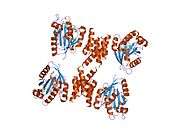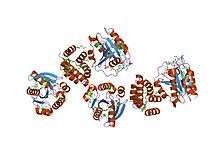ARL1
ADP-ribosylation factor-like protein 1 is a protein that in humans is encoded by the ARL1 gene.[5]
Function
The protein encoded by this gene belongs to the ARL (ADP-ribosylation factor-like) family of proteins, which are structurally related to ADP-ribosylation factors (ARFs). ARFs, described as activators of cholera toxin (CT) ADP-ribosyltransferase activity, regulate intracellular vesicular membrane trafficking, and stimulate a phospholipase D (PLD) isoform. Although, ARL proteins were initially thought not to activate CT or PLD, later work showed that they are weak stimulators of PLD and CT in a phospholipid dependent manner.[5]
Interactions
ARL1 has been shown to interact with GOLGA4[6][7] and GOLGA1.[6]
References
- 1 2 3 GRCh38: Ensembl release 89: ENSG00000120805 - Ensembl, May 2017
- 1 2 3 GRCm38: Ensembl release 89: ENSMUSG00000060904 - Ensembl, May 2017
- ↑ "Human PubMed Reference:".
- ↑ "Mouse PubMed Reference:".
- 1 2 "Entrez Gene: ARL1 ADP-ribosylation factor-like 1".
- 1 2 Lu L, Hong W (September 2003). "Interaction of Arl1-GTP with GRIP domains recruits autoantigens Golgin-97 and Golgin-245/p230 onto the Golgi". Mol. Biol. Cell. 14 (9): 3767–81. doi:10.1091/mbc.E03-01-0864. PMC 196566. PMID 12972563.
- ↑ Van Valkenburgh H, Shern JF, Sharer JD, Zhu X, Kahn RA (June 2001). "ADP-ribosylation factors (ARFs) and ARF-like 1 (ARL1) have both specific and shared effectors: characterizing ARL1-binding proteins". J. Biol. Chem. 276 (25): 22826–37. doi:10.1074/jbc.M102359200. PMID 11303027.
External links
- Human ARL1 genome location and ARL1 gene details page in the UCSC Genome Browser.
Further reading
- Zhang GF, Patton WA, Lee FJ, Liyanage M, Han JS, Rhee SG, Moss J, Vaughan M (1995). "Different ARF domains are required for the activation of cholera toxin and phospholipase D". J. Biol. Chem. 270 (1): 21–4. doi:10.1074/jbc.270.1.21. PMID 7814376.
- Hong JX, Lee FJ, Patton WA, Lin CY, Moss J, Vaughan M (1998). "Phospholipid- and GTP-dependent activation of cholera toxin and phospholipase D by human ADP-ribosylation factor-like protein 1 (HARL1)". J. Biol. Chem. 273 (25): 15872–6. doi:10.1074/jbc.273.25.15872. PMID 9624189.
- Zhao L, Helms JB, Brunner J, Wieland FT (1999). "GTP-dependent binding of ADP-ribosylation factor to coatomer in close proximity to the binding site for dilysine retrieval motifs and p23". J. Biol. Chem. 274 (20): 14198–203. doi:10.1074/jbc.274.20.14198. PMID 10318838.
- Hartley JL, Temple GF, Brasch MA (2000). "DNA cloning using in vitro site-specific recombination". Genome Res. 10 (11): 1788–95. doi:10.1101/gr.143000. PMC 310948. PMID 11076863.
- Wiemann S, Weil B, Wellenreuther R, Gassenhuber J, Glassl S, Ansorge W, Böcher M, Blöcker H, Bauersachs S, Blum H, Lauber J, Düsterhöft A, Beyer A, Köhrer K, Strack N, Mewes HW, Ottenwälder B, Obermaier B, Tampe J, Heubner D, Wambutt R, Korn B, Klein M, Poustka A (2001). "Toward a catalog of human genes and proteins: sequencing and analysis of 500 novel complete protein coding human cDNAs". Genome Res. 11 (3): 422–35. doi:10.1101/gr.GR1547R. PMC 311072. PMID 11230166.
- Simpson JC, Wellenreuther R, Poustka A, Pepperkok R, Wiemann S (2000). "Systematic subcellular localization of novel proteins identified by large-scale cDNA sequencing". EMBO Rep. 1 (3): 287–92. doi:10.1093/embo-reports/kvd058. PMC 1083732. PMID 11256614.
- Van Valkenburgh H, Shern JF, Sharer JD, Zhu X, Kahn RA (2001). "ADP-ribosylation factors (ARFs) and ARF-like 1 (ARL1) have both specific and shared effectors: characterizing ARL1-binding proteins". J. Biol. Chem. 276 (25): 22826–37. doi:10.1074/jbc.M102359200. PMID 11303027.
- Lu L, Hong W (2003). "Interaction of Arl1-GTP with GRIP domains recruits autoantigens Golgin-97 and Golgin-245/p230 onto the Golgi". Mol. Biol. Cell. 14 (9): 3767–81. doi:10.1091/mbc.E03-01-0864. PMC 196566. PMID 12972563.
- Lu L, Tai G, Hong W (2004). "Autoantigen Golgin-97, an effector of Arl1 GTPase, participates in traffic from the endosome to the trans-golgi network". Mol. Biol. Cell. 15 (10): 4426–43. doi:10.1091/mbc.E03-12-0872. PMC 519138. PMID 15269279.
- Wiemann S, Arlt D, Huber W, Wellenreuther R, Schleeger S, Mehrle A, Bechtel S, Sauermann M, Korf U, Pepperkok R, Sültmann H, Poustka A (2004). "From ORFeome to biology: a functional genomics pipeline". Genome Res. 14 (10B): 2136–44. doi:10.1101/gr.2576704. PMC 528930. PMID 15489336.
- Mehrle A, Rosenfelder H, Schupp I, del Val C, Arlt D, Hahne F, Bechtel S, Simpson J, Hofmann O, Hide W, Glatting KH, Huber W, Pepperkok R, Poustka A, Wiemann S (2006). "The LIFEdb database in 2006". Nucleic Acids Res. 34 (Database issue): D415–8. doi:10.1093/nar/gkj139. PMC 1347501. PMID 16381901.
- Zahn C, Hommel A, Lu L, Hong W, Walther DJ, Florian S, Joost HG, Schürmann A (2007). "Knockout of Arfrp1 leads to disruption of ARF-like1 (ARL1) targeting to the trans-Golgi in mouse embryos and HeLa cells". Mol. Membr. Biol. 23 (6): 475–85. doi:10.1080/09687860600840100. PMID 17127620.
- Ewing RM, Chu P, Elisma F, Li H, Taylor P, Climie S, McBroom-Cerajewski L, Robinson MD, O'Connor L, Li M, Taylor R, Dharsee M, Ho Y, Heilbut A, Moore L, Zhang S, Ornatsky O, Bukhman YV, Ethier M, Sheng Y, Vasilescu J, Abu-Farha M, Lambert JP, Duewel HS, Stewart II, Kuehl B, Hogue K, Colwill K, Gladwish K, Muskat B, Kinach R, Adams SL, Moran MF, Morin GB, Topaloglou T, Figeys D (2007). "Large-scale mapping of human protein-protein interactions by mass spectrometry". Mol. Syst. Biol. 3 (1): 89. doi:10.1038/msb4100134. PMC 1847948. PMID 17353931.
This article is issued from
Wikipedia.
The text is licensed under Creative Commons - Attribution - Sharealike.
Additional terms may apply for the media files.









